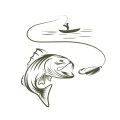Understanding Bite Detection: The Basics
Feeder fishing in the UK is a pursuit that balances time-honoured tradition with scientific insight, and nowhere is this blend more apparent than in the art of bite detection. At its core, bite detection is all about interpreting subtle signals transmitted from fish to angler through a carefully chosen setup. To truly appreciate the science behind it, we must first explore how fish interact with bait beneath the surface. In most British waters, species such as bream, tench, and roach approach a feeder with a blend of caution and curiosity, investigating offerings before committing to a take. Their behaviours—gentle mouthing, tentative pulls, or bold lunges—create distinct vibrations and tension changes along your line. These are the sensory cues that a well-tuned feeder rig can reveal. A sensitive tip or quiver responds to even the lightest touch, translating underwater activity into visible movement above the waterline. Understanding these basic interactions is vital for any angler hoping to maximise their success on UK rivers and lakes, allowing them to distinguish between genuine bites and background noise caused by currents or drifting weed.
2. Feeder Styles and Bite Indication in British Waters
Feeder fishing across the UK is shaped by a diverse range of water types, from the slow-moving canals of the Midlands to the fast-flowing chalk streams of the South. Selecting the right feeder style is crucial for bite detection and overall success, especially when considering local fish species such as bream, roach, tench, and carp. Let’s review some of the most popular feeder types used in British waters and evaluate their effectiveness for bite indication under varying conditions.
Popular Feeder Types in the UK
| Feeder Type | Best For | Bite Detection Sensitivity | Common Target Species | Typical Water Conditions |
|---|---|---|---|---|
| Cage Feeder | Loose groundbait presentation | High – open structure transmits subtle bites well | Bream, roach, skimmers | Stillwaters, slow rivers |
| Method Feeder | Tight baiting around hookbait | Moderate – robust design can mask gentle takes | Carp, tench, large bream | Lakes, commercials |
| Open-End Feeder | Maggot/caster introduction | Very High – especially with light rods and tips | Roach, dace, chub | Rivers with moderate flow, canals |
| Blockend Feeder (Magnet) | Maggot-heavy tactics in flowing water | Moderate – designed for aggressive bites in current | Dace, chub, perch | Fast rivers, tidal stretches |
| Bolt Rig/Inline Feeder | Tough venues with wary fish | Low to Moderate – self-hooking action means bites often register late or as drop-backs | Big carp, barbel | Larger stillwaters, strong rivers |
The Importance of Matching Feeder to Local Conditions
The science of bite detection hinges on matching your feeder not only to your target species but also to prevailing water conditions. For example, cage feeders excel in clear stillwaters where shy-biting bream require subtlety. In contrast, blockend feeders are indispensable on fast-moving rivers where you need a steady release of maggots and robust construction to handle current and debris. Understanding how different feeders interact with flow rates and bottom contours enables anglers to fine-tune their approach—maximising both presentation and the sensitivity needed to spot even the faintest tremor on the quivertip.

3. Tactics for Reading Subtle Bites
Mastering the art of bite detection in British feeder fishing often hinges on your ability to interpret the most delicate of indications. UK waters, whether you’re angling on a classic stillwater or a winding river, frequently host finicky species like roach, skimmers, and wary bream that seldom commit to aggressive takes. The secret lies in cultivating an observant mindset, where every quiver of the tip or minor twitch in the line becomes a conversation between angler and fish.
Understanding Environmental Influences
The British climate brings its share of blustery winds and sudden rain squalls, both of which can mask or exaggerate genuine bites. It’s essential to adjust your rod positioning—low to the water in windy conditions—and choose a sensitive quiver tip matched to your target species and prevailing weather. Fine-tuning your setup helps filter out false signals caused by tow or drifting debris, allowing true bites to stand out.
Reading the Rhythm
British feeder anglers often speak of “rhythm”—the pattern and tempo of bites unique to each venue and session. Train your eye to spot subtle differences: is the tip trembling with current, or does it pause momentarily before dipping? Experience teaches you when a slow, deliberate pull signals a feeding tench versus the erratic plucks of small perch. Keeping your focus sharp means you’ll respond decisively when it matters.
Tackle Adjustments for Finesse
Switching down to finer hooklengths, lighter feeders, and using low-stretch mainlines like braid can significantly increase sensitivity. On pressured UK venues, fish can be suspicious—so every advantage counts. Pair this with small hooks baited with single maggots or pinkies for winter sessions, giving you a better chance at detecting even the lightest nibbles.
Patience and Practice
No amount of equipment can substitute for time spent bankside observing how different species express themselves through your rod tip. Keep a mental note of how each bite develops—sometimes a hesitant tap is all you get before a shy fish drops the bait. With patience and repeated exposure to British waters, you’ll soon develop an instinct for those fleeting moments that separate missed opportunities from memorable catches.
4. Choosing the Perfect Bite Indicator for UK Conditions
When it comes to feeder fishing on British waters, selecting the right bite indicator is a subtle art shaped by ever-changing weather and light. The UK’s unpredictable drizzle, low winter sun, and breezy afternoons all play their part in dictating which indicator excels on the bank. Let’s compare traditional quiver tips, electronic alarms, and high-visibility (hi-viz) options, with a discerning eye on what truly works under classic UK conditions.
Comparing Popular Bite Indicators
| Bite Indicator Type | Best Suited For | Advantages | Limitations |
|---|---|---|---|
| Traditional Quiver Tip | Stillwaters & slow rivers; moderate to calm days | Natural feel; visual clarity in daylight; sensitive to subtle bites | Harder to see in poor light or at distance; wind can cause false signals |
| Electronic Alarm | Night fishing; poor visibility; windy banks | Audible alert; great for social sessions or multiple rods; reliable in darkness or fog | Batteries required; may lack sensitivity for shy feeders; can be intrusive in quiet settings |
| Hi-Viz Tips/Bobbins | Dull days; low sun angles; weedy swims | Excellent visibility against grey skies or glare; easy bite detection from afar | May spook wary fish in clear water; not as traditional as plain tips |
Tailoring Your Choice to UK Light & Weather Patterns
Misty Mornings & Overcast Skies: Hi-viz tips come into their own, cutting through gloom and helping you spot delicate twitches that might otherwise go unnoticed.
Breezy Afternoons: Opt for a slightly stiffer quiver tip or consider an electronic alarm set-up to reduce false positives caused by wind gusts.
Dawn & Dusk Sessions: Electronic alarms provide invaluable audio cues when your eyes are adjusting to changing light. A combination of a bright tip and alarm maximises detection.
Bright Summer Days: Classic quiver tips work beautifully when glare is less of an issue, especially if you’re seeking that tactile connection to every pluck and pull.
A Word on Adaptability: Mix and Match!
The seasoned UK feeder angler often carries more than one type of bite indicator. Swapping out a hi-viz tip for an alarm as dusk falls, or doubling up with both for extra peace of mind during changeable weather, ensures no take goes undetected. Always consider the colour of your chosen tip against prevailing conditions—fluorescent orange or yellow stands out on gloomy days, while white may be preferable against rich summer greens.
Summary Table: Quick Guide to Bite Indicator Selection
| Condition | Recommended Indicator(s) |
|---|---|
| Misty/Overcast Morning | Hi-viz tip (orange/yellow) |
| Breezy Afternoon | Stiff quiver tip or electronic alarm |
| Dusk/Night Fishing | Electronic alarm + hi-viz tip combo |
| Bright Clear Day | Traditional quiver tip (neutral colour) |
The science of bite detection is as much about observing nature as it is about understanding your kit. In true British style, adaptability—and a little experimentation—ensures you’re always ready to outwit both fish and fickle weather.
5. Fine-Tuning Your Feeder Fishing Setup
When it comes to maximising bite detection on British waters, a meticulous approach to your feeder fishing setup is essential. The often subtle takes of wary UK fish, such as roach or bream in pressured venues, demand that every detail is considered. Let’s break down the key elements you’ll want to optimise: rod rests, line tension, and terminal tackle.
Rod Rests: Stability Meets Sensitivity
The humble rod rest plays a crucial role in translating delicate bites into visible movement at the tip. Opt for a stable, adjustable rest that allows fine-tuning of your rod angle. On windy days or when targeting species notorious for finicky bites, position the rod low and parallel to the water to reduce wind drag and enhance tip sensitivity. In contrast, raising the rod can help keep line off surface weed or reduce tow on sluggish rivers. A soft foam rest reduces vibration transfer and clatter—crucial for not spooking cagey carp or tench patrolling near the bank.
Line Tension: The Goldilocks Principle
Getting your line tension “just right” can be the difference between a blank and a bumper haul. Too slack, and you risk missing shy plucks; too tight, and you may inadvertently move your feeder or deter cautious fish. After casting out, allow your feeder to settle before gently tightening up so there’s a subtle curve in the quivertip—a hallmark of British match style fishing. This way, even the most tentative lift will register as a clear indication without causing undue resistance at the business end.
Terminal Tackle: Subtle Yet Effective
On pressured UK venues where fish have seen it all, finesse is your ally. Use light lines (consider 0.14mm-0.18mm fluorocarbon for bream or skimmers), small hooks (size 16-18 for maggot or pinkie), and streamlined feeders that blend into the bottom. Short hooklengths (10-20cm) can increase bite registration on stillwaters, while longer ones may suit slow-flowing rivers where fish mouth the bait more warily. Always tailor your approach to the conditions and target species—subtle tweaks can have outsized results.
Tip:
Adding a small dropper shot just above the hook can enhance visual bite registration without scaring off nervous British fish—especially effective when targeting silvers on clear canals.
Summary
By paying attention to rod positioning, maintaining optimal line tension, and refining your terminal tackle to suit UK conditions, you’ll elevate your bite detection game while keeping even the wariest quarry confident enough to feed.
6. Weather and Water Science: Adapting to Changeable Conditions
Every British angler knows the joys and frustrations of fishing under skies that can shift from blazing sun to a drizzly chill in the space of an hour. Understanding how weather and water conditions impact bite detection is crucial for consistent success with your feeder setup. In the UK, our waterways are famously fickle—wind patterns, rainfall, temperature swings and even atmospheric pressure can alter fish behaviour and the subtleties of a bite.
The Impact of Weather on Bite Sensitivity
British weather can turn on a sixpence, demanding a flexible approach from even the most seasoned feeder angler. On blustery days, wind can create drag on your line or mask gentle bites, making it vital to select heavier feeders or adjust your rod position to maintain sensitivity. Conversely, during flat calm spells, switching to lighter tips or more sensitive quiver tips will help register those finicky winter plucks that might otherwise go unnoticed.
Reading Water Conditions: Flow and Clarity
Our rivers and lakes respond quickly to rainfall, often becoming coloured or running faster after a downpour. These changes can affect how fish feed and how bites register at your rod tip. In murky water, fish may be bolder but bites less pronounced; try shortening your hooklengths or using larger baits for clearer indications. When the flow increases, step up to heavier feeders to keep your rig anchored and in touch with subtle takes.
Seasonal Shifts and Year-Round Consistency
Seasonality is woven into the fabric of UK feeder fishing. During colder months, fish metabolism slows, bites become more tentative and detection requires extra finesse—think ultra-fine lines and delicate tips. As spring and summer warmth returns, bites often become more positive but weed growth and insect hatches can add new variables. Adapting your setup to these seasonal nuances—by tweaking line diameter, feeder size or hook pattern—will ensure you stay one step ahead whatever the calendar says.
Practical Adaptations for Unpredictable Days
In true British style, preparation is everything. Always bring a selection of feeder weights, tips with varying sensitivities and a few alternative rigs so you can adapt swiftly if conditions change mid-session. Keep an eye on weather forecasts but don’t be afraid to experiment bankside—the best anglers are those who read the water as well as their kit. By embracing the science of weather and water dynamics, you’ll maximise your bite detection potential year-round—rain or shine.


